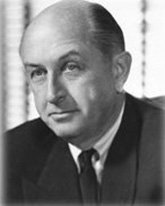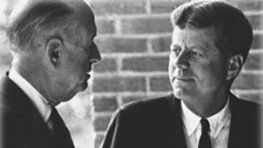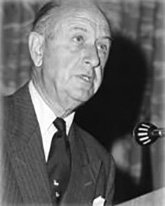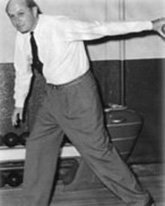3rd President of the World Bank Group, July 1, 1949 - December 31, 1962
He assembled a growing international staff that brought experience and imagination to tackle the demands of an expanding membership. Lending increased rapidly, and covered virtually all sectors relevant to economic progress, including infrastructure, industry, agriculture, and education. In response to the changing needs of the membership two major affiliates were created: the International Finance Corporation (IFC) and the International Development Association (IDA). He established the role of the Bank as an impartial mediator in international disputes, and considered the Indus Basin treaty as the Bank's most important achievement.
Personal History
Eugene Robert Black was born in 1898 in Atlanta, Georgia. He graduated from the University of Georgia, and enlisted in the U.S. Navy, where he served on convoy duty in the North Atlantic during World War I. After the war he joined the investment firm of Harris, Forbes, & Co., and later opened the first southern office of the firm in Atlanta. He traveled widely selling bonds, meeting bankers and investors, and eventually became a partner. In 1933 he joined the Chase National Bank as vice president, and was eventually promoted to senior vice president responsible for Chase National's large investment portfolio. He became the U.S. executive director for the Bank in 1947, and became an effective member of the triumvirate (with President John J. McCloy and Vice President Robert L. Garner) that managed the Bank in its early years. Upon McCloy's resignation, Black was nominated - against his will - as President of the Bank.
Black had wanted to return to Chase National, but his experience with the Bank, and his previous experience in the investment community made him the ideal candidate for the position. His background, his work as a banker, and his style marked him as thoroughly conservative. Without sharing the anti-communist fervor of the postwar era, he was deeply concerned about the threat of spreading communism and its impact on the restoration of a functioning global, capitalist economy. He was a firm believer in democratic values; economic prosperity was for him the essential prerequisite for political freedom. It was for this reason that he was personally committed to the objectives of the Bank: improving the living conditions and economic prospects of its members, especially the poorest among them.
Mobilizing Resources
One of the major challenges facing Black when he became president was to find usable capital for the Bank's operations. He spent much time (starting during his tenure as US executive director) to the task of promoting the credit of the Bank and its access to the U.S. capital market. The lack of enabling legislation was in impediment to this access: national banks could not invest in the Bank's bonds without congressional legislation; insurance companies, savings institutions, pension funds, and fiduciary trusts could not invest in the Bank's paper without the authorization of their state legislatures. Black therefore spent much time persuading members of the U.S. and state legislatures to pass the requisite laws. Progress was slow, but enabling legislation gradually came into being.
From its first bond issuance in 1947, the Bank had enjoyed favorable credit ratings in the U.S. investment market. When the European capital markets shown sign of postwar revival, Black started a marketing campaign in Europe.
In 1950 the Paris and Amsterdam stock exchanges started trading the Bank's dollar bonds. Throughout the early 1950s, an increasing number of banking institutions abroad began investing in the Bank's securities. Black's familiarity and contacts with the international investment community facilitated the rapid growth of this essential aspect of Bank financing.
Black also worked toward obtaining the release of the so-called 18 percent portion of members- subscriptions - the portion that could be paid to the Bank in the member's own currency. Black worried about the lack of non-dollar funds, fearing that the World Bank would become a "dollar bank." Hesitant progress was made in persuading members to allow more generous releases. At one point Black forced the issue by making assistance to Yugoslavia contingent on the availability of 18 percent releases. Eventually the European postwar recovery and the accumulation of large dollar balances outside the U.S. in the late 1950s made it possible for a growing number of members to agree to a fully convertible release of their 18 percent subscriptions.
Another increasingly significant source of funds in the 1950s was the sale of participations in Bank loans or of part of the Bank's loan portfolio. For Black, the fact that the Bank's borrowers were thus introduced to the international capital markets was in itself more important than the additional resources that were made available for the Bank. Initially, sales were made with the Bank's guarantee. Starting in 1950, however, participations and portfolio sales without the Bank's guarantee became common. By 1962 participations reached a peak of $319 million, or 36% of the level of commitments in that year.
While gaining the trust of its creditors, the Bank was establishing its reputation in the developing countries as the gatekeeper of the international financial markets. Black came to personify access to those markets and to the people who controlled them.
Establishing the Bank's reputation as a financially sound institution with an impeccable credit record was Black's most important achievement. He made a significant personal contribution to the introduction of the Bank into international financial markets. In this process he showed great political skill, particularly in seeing through the passage of critical U.S. legislation. The energy he brought to the task showed how much he enjoyed being the Banker-Diplomat.
Establishing Operational Principles
Black emphasized the apolitical nature of the Bank's business and the professional care it exercised in selecting sound, economically justified investments. He consistently emphasized the soundness of the Bank's lending activities, especially those activities in the developing world. India and Latin America were frequently used examples of the cautious and conservative approach that the Bank took in financing investments.
Black was a strong proponent of the project concept in the Bank's lending. He felt that "general purpose" loans or loans for vague development plans might be used for projects which were economically or technically unsound or of low priority, or to finance unjustified consumer goods imports. It was his particular concern to ensure that the projects taken up by the Bank were economically of high priority and that the resources provided for a Bank supported project were to be used for the most essential projects. To identify the appropriate national economic context of project investments, Black put strong emphasis on the need for carefully prepared national development plans. He felt that governments should establish a sensible order of investment priorities so that limited resources could be used to best support the national economy. He was adamant that the Bank's money should be used for projects of the highest priority.
This emphasis on well-informed economic planning led to the Bank's early foray into the field of technical assistance. Technical assistance activities grew in number, as member countries recognized the Bank's expertise in a wide field of economic activity. Countries that did not have a clearly worked-out set of economic priorities were encouraged to come to the Bank for assistance. The Bank conducted a great number of comprehensive economic surveys at the requests of member governments; the first of these took place in Colombia in 1949. General survey missions were especially important for former colonial states in Africa and elsewhere. The survey missions represented a step in the transformation of the Bank into a development institution.
The fifth annual report - issued in the second year of Black's presidency - outlined the Bank's operational policies. It stated that in its earliest activities the Bank needed to be flexible in its lending policies, but by 1949-50 the policies were stable enough to be formally defined. The formal statement of these policies demonstrated that the Bank was becoming an established institution.
International Mediation
Black's talent for dealing with people had an important practical dimension: his knack for bargaining and negotiating. Because of his skill as a negotiator, he earned an international reputation as a mediator of wise judgment and absolute integrity. Black's insistence that member countries make reasonable efforts to settle claims arising from financial defaults or the nationalization of foreign properties was influential in settling foreign investment disputes. The Bank, and Black personally, acquired a reputation for expertise in resolving complicated financial disputes.
Black saw international mediation as an essential aspect of the Bank's business - part of the Bank's service to its members. In addition to resolving disputes, the Bank's intermediation helped member governments to develop reasonable business and financial practices.
For the most part, Black did not seek out disputes for the Bank to mediate. However, in one instance he did initiate the Bank's role - the resolution of the long'standing dispute between India and Pakistan over the use of water resources in the Indus Basin. Black personally approached the leaders of India and Pakistan and suggested that the Bank provide the technical assistance to resolve their dispute. Both leaders eventually agreed, and the negotiations began, continuing for a period of nine years until the final treaty was signed by both parties in 1960. Black was also successful in the settlement of claims arising from the nationalization of the Suez Canal. The Bank also attempted a resolution of the dispute between the Iranian government and the British shareholders of the Anglo-Iranian Oil Company, but was unsuccessful in this attempt.
Vision of Progress
When the Bank opened for business, the question of why some countries were under-developed was only dimly perceived. It was only after Black became president that the Bank started to focus on the new challenge of economic development. The Bank had a number of very able economists on its staff, and they were looking at the problems of developing countries and beginning to come up with solutions. Black's understanding of the development process allowed him to determine the basic direction of the Bank's work.
Black had a vivid sense of the meaning of underdevelopment. Extensive trips to the Bank's member countries allowed him to see firsthand the living and working conditions of the population. Compassion and curiosity made him take full advantage of the opportunity for extensive field visits. And he sought to convey to his audiences in the developed world some sense of the disparity between rich and poor countries, and the tensions created by the ever-widening gap between industrial and developing countries. He felt a compelling need to speed the development process because the problems would only increase with time. And he realized that world stability could not be achieved if whole populations were "engaged in a tooth-and-nail struggle merely to keep themselves alive."
Black recognized that economic development would be quite unlike ordinary investment banking. It would need to be conducted within the context of a comprehensive assessment of the country economy, and take into account the broad variety of elements that contributed to development. Black, and those around him, believed that under-development was caused primarily by the lack of modern technology. In the 1954 Annual Meetings address to the Governors he presented a vision of progress: "tractors working on land that before had only known the bullock…small factories working where industry had never appeared before… (mountain) streams being harnessed to produce energy…hundreds of miles of pipe bringing natural gas… Down in the villages… grain being milled by machinery, instead of being pounded out by hand, and electric light replacing the oil lamp."
Black realized that the most important resources for development must come from the developing countries themselves, in the form of the adoption of appropriate fiscal policies, and the introduction of tax systems and expenditure policies that would leave the governments adequate resources for development. Despite the emphasis on technological improvement prevalent during Black's era, many of the elements that are now commonly accepted as vital to economic development - policy reform, structural change, improved governance, overpopulation, education, institutional capacity and effective public administration - were beginning to be recognized by the Bank at this time.
"The Bank's work is not to be assessed in terms of the building of cold monuments of stone and steel and concrete; it has had a deeper purpose - to enlarge the riches of the earth, to give men light and warmth, to lift them our of drudgery and despair, to interest them in the stirring of ideas, in the grasp of organization and techniques toward the realization of a day in which plenty will be a real possibility and not a distant dream."
Expanding the Bank
As the Bank's experience with economic development grew, the limitations inherent in the conventional banking concept became more evident, and the need to broaden the scope of the institution was seen. The Bank's Articles of Agreement restricted its activities in two areas: finance for the private sector, and finance for the poorest countries.
The Bank's lending to the private sector was constrained by the requirement of government guarantees for its lending. The Bank, and Black personally, considered private investment to be an important factor in economic development, particularly investment in the industrial sector. When Black came to the Bank, the idea of an affiliate organization to stimulate private investment had already been suggested by some Bank staff members. Black pursued the idea vigorously, and it came to fruition with the creation of the International Finance Corporation (IFC) in 1956. During the seven year attempt to get approval for IFC, Black persuaded financial and legislative circles in the U.S. of the merits of the proposal, and he enlisted the support of an unusual ally - the United Nations. Until this point the Bank had carefully distanced itself from the UN, but Black's pragmatism allowed him to work in concert with the UN to achieve a goal which would further economic development in the developing world.
The International Development Association (IDA) was also created during Black's tenure. IDA - the Bank's "soft loan" affiliate - had its origins in the early days of the Bank as the poorest member countries sought capital on terms less onerous than those the Bank normally offered. The Bank initially rejected this concept, thinking that the Bank's reputation for sound, hard-nosed business-like projects would be undercut by lending on other than market-based terms. Black himself felt that if there was a need for concessionary lending it should be in the form of bilateral grants, not loans from the Bank. By 1958, however, Black reversed his thinking. He recognized that some rapidly developing member countries were approaching the limits of their capacity to assume additional obligations. The newly independent African countries were particularly in need of readily available funding. He thus welcomed the proposal from U.S. Senator Mike Monroney for the establishment of a concessionary loan affiliate, and IDA was established in 1960.
The establishment of IDA meant the recognition that there was a legitimate need for concessional assistance and that the Bank could provide this assistance without compromising its strict standards for lending. However, IDA, with its periodic replenishments by member governments, meant that the Bank had to pay increasing attention to the views and priorities of the parliamentary bodies that provided the replenishment funds. Whereas the Bank had previously to consider only the productive and economic aspects of lending, now the internal politics of the shareholding governments began to play a larger role in the Bank's activities. The periodic IDA replenishments and the need to satisfy the donor governments were to become a major challenge for Black's successors.
The creation of IFC and IDA complemented the original International Bank for Reconstruction and Development, and the Bank could now able to assist all its members regardless of their income level and debt'service capacity. The three affiliates signaled the transformation of the World Bank into a development institution.
Black's Bank
When Black became the third president of the World Bank he took over an institution that was just beginning to function. The Bank was relatively unknown; its mission was understood by only a few, and many of those regarded it as an interesting but risky experiment. Even within the Bank, staff had not yet developed a clear vision of its role and potential.
Black was a much-liked, popular CEO to the Bank staff. Although he considerably expanded the staff, he knew practically everyone in the Bank and took a personal interest in their families. Christmas parties, bowling tournaments, and annual picnics in Rock Creek Park with softball games were regular occasions for Black to interact with the staff and their families.
Black's departure from the Bank in 1962 signified the end of an "era of good feeling" that had typified "Black's Bank." The era had been dominated by Black's personality, his leadership, his graceful style, and charm; it was also an era during which the Bank enjoyed universal respect and acclaim. The leaders of the developed and developing worlds respected the principles for which the Bank stood, and recognized the financial and technical integrity of the institution. Black successfully faced the challenge of creating a development institution. His successors would need to adapt this institution to face new challenges in the years ahead.



